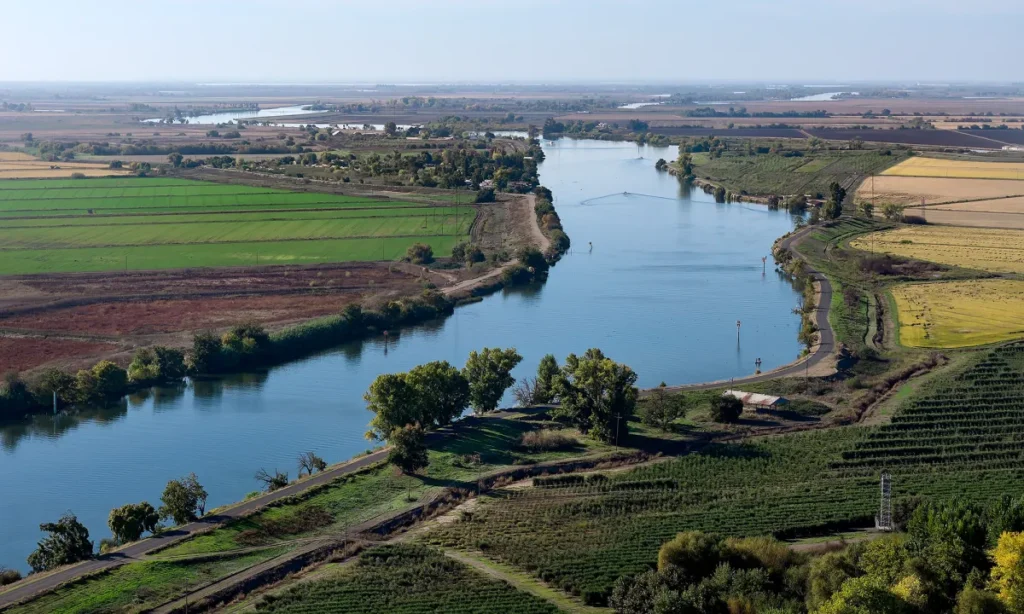Share
From Yosemite Valley to the Golden Gate, California boasts extraordinary vistas. But if you’re looking for the most thought-provoking view in the state, skip the beaches and mountains, and head for Bakersfield’s Panorama Park.
When you walk through this narrow neighborhood park atop the Panorama Bluffs on Bakersfield’s northern edge, you don’t actually see everything. It only seems like you can.

Joe Mathews
Opinion
The view also provides undeniable evidence that in California, you really can defy the laws of chemistry: oil and water mix here, perhaps too well.
The water appears first. The Kern River meanders below the park’s bluffs, amidst willows, cottonwoods, and sycamores. This pastoral river can feel like an oasis amidst the larger, drier landscape. But it’s also a portal into the past.
The landscape you see from Panorama Park used to be one of California’s wetter places, with rivers and lakes. In heavy rains or heavy snowmelt in the Sierra, the middle of California would become an inland sea.
But beginning in the 19th century, farmers tamed those volatile river and lake waters, eventually creating today’s drier landscape. Dams and canals went in. From Panorama Park, you can see two of the first: Beardsley Canal and Carrier Canal. Water supplying the Carrier Canal also feeds the Kern Island Canal — Bakersfield once had so much water around it that its name was Kern Island.
A Redoubt of Reactionary Republicanism in a Blue State
Bakersfield is still an island — perhaps California’s largest isle — in politics and culture. It’s a redoubt of reactionary Republicanism in a blue state, and an oil economy surrounded by the more agricultural San Joaquin Valley.
The vista from Panorama Park demonstrates this. Beyond the river, oil fields stretch north, further than your eye can see. The stretches of oil derricks, like the trees in Sequoia National Park, are so vast that they don’t fit the human field of vision, and can’t be easily photographed.
Kern River Oil Field helped turn California into America’s leading oil producer in the early 20th century. It brought people from around the world, to work and live here. From Panorama Park you can see Oildale, where Merle Haggard grew up in a boxcar, and wrote a song about it:
The oil tanker train from down on the river
In Southern Pacific and Santa Fe names
Would rumble and rattle the old boxcar we lived in
And I was a kid then and I loved that old train
Haggard popularized the brand of country music known as the Bakersfield Sound. You can visit his family boxcar at the Kern County Museum. Poor people, successors to the Haggards, still live out there, and still pay too much for sub-standard housing.
The Kern River Oil Field has produced two billion barrels and counting. But its output has fallen dramatically since 1985; production has been propped up by pushing steam into the wells to draw out the sticky remaining oil. This is a costly practice, both economically and environmentally, and support for the oil business is not bottomless, even here. An appellate court recently ordered Kern County to halt new oil permits. From Panorama Park, you’re looking at an industry in decline.
The View From Bakersfield Really Makes You Think
Bakersfield is changing in other ways, too. If you stand in the park and turn away from river and the oilfields, you’ll see Alta Vista-La Cresta, one of the city’s older neighborhoods. The Alta Vista tract was first laid out by Donald McClaren, son of John McClaren, who put together San Francisco’s Golden Gate Park. This was once a distinguished address — its denizens had those grand views — but the area has been fading ever since Bakersfield expanded west of Highway 99, and richer people bought places in neighborhoods like Seven Oaks.
The Panorama Vista — specifically, the area between the bluffs and the oil fields to the north — has been the focus of successful restoration for more than a generation. It’s been called the Panorama Vista Preserve since 2004, and visitors there enjoy trails and a native plant nursery.
It’s not hard to imagine the preserve growing larger, and the vista changing. As California responds to climate change, the state will turn harder against oil. In the 50 years, the pumpjacks might well be gone, replaced by park space, solar energy farms, or some of the new homes California needs to build.
These days, water already feels like a more precious commodity than oil. And this land, if restored to its original state, could fill with it. Will some dams be removed? Will the vista become wetter again?
The view from Bakersfield really makes you think.
About the Author
Joe Mathews writes the Connecting California column for Zócalo Public Square.
RELATED TOPICS:
Categories

Trump Signs Order Aimed at Curbing State AI Laws


















